How to Cite | Publication History | PlumX Article Matrix
Distribution and Morphological Adaptations of Avicennia Marina in the Sundarbans
Nizam Uddin Farooqui and C.B.S.Dangi
Department of Biotechnology, R.K.D.F. University, Gandhinagar Bhopal (M.P) 462033, India.
Corresponding Author E-mail: nizy_farooqui@hotmail.com
DOI : http://dx.doi.org/10.13005/bbra/2626
ABSTRACT: Many factors contribute to the morphological variations in the members of a species of the plants grown in different areas and ecosystems. In such a way, Avicennia is woody trees or shrubs which grow near the coastal areas. Scientists Moldenke 1975 & Tomlinson 1986 recorded the considerable morphological differences in the leaves and flowers of Mangroves. The objective of the present work is to find out the complete morphological variations among the members of Avicennia grown in inland and marine systems
KEYWORDS: Morphological variation; Ecosystem, Sundarbans
Download this article as:| Copy the following to cite this article: Farooqui N. U, Dangi C. B. S. Distribution and Morphological Adaptations of Avicennia Marina in the Sundarbans. Biosci Biotech Res Asia 2018;15(1). |
| Copy the following to cite this URL: Farooqui N. U, Dangi C. B. S. Distribution and Morphological Adaptations of Avicennia Marina in the Sundarbans. Biosci Biotech Res Asia 2018;15(1). Available from: https://www.biotech-asia.org/?p=29680 |
Introduction:
The word “mangrove” was usually believed as chief compound of Portuguese word “mangue” and English word “grove.” Mostly used words in French were “manglier” and “paletuvier” [1]. In Spanish the term is coined as “manglar”. The term “vloedbosschen” is used by the Dutch for the mangrove community and when they talk about the single or individual trees they called it “mangrove”. Basically the term”mangro” is considered to be common name for Rhizophora.
“manggi” word being originated from the Malaysian word, which means above soil. But the use of the word is stopped in Malaysia and it is believed to be used in eastern Indonesia more than the origin. In Indonesia it is refers to Avicennia species.
Mangroves were quite old and it might have possibly arised. About 125 million years ago after the first angiosperm there were basically Avicennia and Rhizophora[3] that evolve around the end of cretaceous period.[4] Some vital information can be extracted from the pollen records which is useful about the subsequent radiation. It is suggested and understood from the studies of fossil pollen from sendiments in Lezihou Peninsula and China there might be possibility of expanding of mangroves from south to north. When they reach their farther end or we should call it a northern limit that is Changjiang Delta in the middle of Holocene, it suggest mangroves were established before 3000 years or more and gradually the sea level decrease with every passing century [5]
According to the recent estimate of Dr. Spalding of over 18 million hectares with 49.5% in south and south eastern parts of Asia. If Indonesia is consider as an addition it is 39.4%. In India Mangroves are mostly found or restricted to 25.N and 25.S mostly in reference to the studies. The limit of the northern extension occur in Japan 31.N and towards south it believed to be in Australia 38.45 S.
Main Factors which can strongly affect the distribution of mangroves is temperature and moisture. [7]. High tides and currents may also limit the distributions by stopping propagates distribution to other areas [8]. Individual mangrove species differ in length along with their ecological success, rate of growth and their power of tolerance. All the above factors, are quite consistent throughout the world, which in return produces characteristic distribution in ranges in almost all the species as illustrated in Table.1.
Table 1: Taxonomy and global distribution of Avicennia
| Species | Distribution |
| Avicennia alba Blume | Southeast Asia , Malay Archipeligo & East Asia, South Asia |
| Avicennia balanophora Stapf and Moldenke ex Molodenke | Australia |
| Avicennia bicolor Standley | Central/South America |
| Avicennia eucalyptifolia (Zipp. ex Miq.) Moldenke | Australia |
| Avicennia germinans (L.) Stearn | Southeast USA & Central/South
America |
| Avicennia lanata Ridley | Malay Archipeligo |
| Avicennia marina (Forsk.). Vierh. | Africa, South Asia, South-east Asia, Malay Archipeligo, East Asia, Australia &
Southwest Pacific |
| Avicennia officinalis L. | Southeast Asia, Malay Archipeligo, East Asia & Australia. |
| Avicennia schaueriana Stapf and Leechman ex Moldenke | Central / South America |
| Avicennia africana Palisot de Beauvois | Africa |
A study from different part of world of pollen were recorded from the Antilles in mexico, the, the northern South America and Central America [8] indicates the neotropical environments were firstly occupied by Nypa, Pelliceria, Acrostichum, and Brevitricolpites variabilis,. About 50 million years. In Miocene Avicennia appeared late in this part (10 million years ago). In the Middle Pliocene six mangrove species were present along with three associated genera. (3.5 million years ago) and during the Quaternary period fifteen plant genera were present. In present-day assemblage of about 27 genera of associated plants and mangroves twelve additional species were added [9]
In near times there had been a geological phenomenon that had produce a mixture and dispersal of genes widely. This change showed the increase in evolutionary process. As it is found that Aviccennia marina is found in temperate latitude and it is mostly found in southern hemisphere
Thus mangroves were evolved in the tropic when tectonic is dispersed because of continental fragment it is said that western Godwana origin with subsequent radiation [11]. Fossils of Mangroves had provided valuable information about the pre historical evolution of mangrove and its dispersal. However, cautions of Burnham regarding reconstructions in organic sector may be substantially different, found in studies of different mangrove parts (e.g., fruits and seedlings vs. leaflets).
Distribution of mangrove according to the old times or historical changes can reveal detail about Paleo Climate and Sea level changes. We can take the examples of Pacific Ocean in equatorial region especially changing the mangrove fossils and the reef in the lower Pliocene deposits and in the upper Miocene [13].Clear Indication shows that mangrove peat had filled the lagoon before 4800 Holocene sediments from Maya wetland of Belize prove this. [14]. When we study farther we can notice the change in large-scale climatic shifts and disturbance in the sea levels. In Poverty Bay, New Zealand, the presence of Avicennia marina indicates that this area was a frost-free climate [15]. The mangrove fossil record is clearly an area where a continued research has the potential for providing significant information about the history of these unique plants.
Materials and Methods
A survey has been conducted recently to study the mangrove vegetation in the Sundarbans with great diversity. We studied the morphology and anatomy of few mangroves species in relation to their adaptation to saline habitat. Leaves, stems, roots from different families of mangrove, materials were collected from those areas during 2016 and they were placed in a polythene bag containing water. Thin sections and cross sections were cut by using a sharp razor blade. The sections were immersed in water to avoid the formation of air bubbles. Sections were stained with Safranine. Excess of stain was washed with water. Then, the sections were stained with fast green solution and the excess dye was washed. Thereafter, small cuttings were mounted in Glycerol and covered with cover slip and observed under microscope.
Results and Discussion
Genetic Variation
There were a significant amount of and internal and external specific differences among variants of mangroves . These Differences can be morphological differences had been noticed between western atlantic species and west african species of Avicennia germinans [16] and A. germinans and Rhizophora have been identified as distinct chemo types [17]. Local environments may have resulted in differences of genotypic or phenotypic responses. Rhizophora mangle of Mexico shows mean leaf area rightly correlated with annual precipitation and negatively correlated with latitude. Photosynthetic efficiency is enhanced through the morphological response to local conditions of the trees [18]. Same case in southeast Florida, leaf area indices can be used to differentiate Rhizophora mangle from basin and dwarf forest types. Rhizophora mangle flower indicates contrast variation in morphology which appears to be genetically based.
Genetic differentiation can be led by the fluctuations in genetic frequency such as those species produced by crossbreeding. Conjugation or inbreeding is accustomed than a mangrove forest can be mono specific with equality of genetic diversity in small number. Bee’s pollination produces geitonogamous selfing in Kandelia candel. Whereas, a little genetic differentiation is seen among thirteen populations in the coastlines of Hong Kong, indicate the fact that the dispersion of propagates is sufficient to maintain high levels of gene flow in this species [19]. In contrast, the concept of genotypic differentiation, has led to sub speciation in Avicennia marina [20]. It has been considered that propagates of Avicennia commonly travel far distances. but, allozyme findings suggest that Avicennia species in the indo-west pacific and eastern North America have limited gene flow. This suggests that true dispersal distances are much shorter then commonly believed [21].
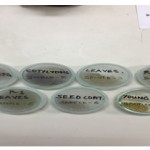 |
Scheme 1
|
Tissue Culture
To pass on the tolerance towards salinity from mangrove to the plants which are non-salt tolerant a technique is used named “Cell Prolopast”. Obtaining and preparing method from tissues culture of Bruguiera gymnorrhiza believed to be created by Eghudhi .et.al. Study have shown the familiar work has been done by Sasamota el with aspects of A. lanata and Avicennia marina. Unique characteristics of mangroves such as salt tolerant can be utilized by researchers to do some creative tissue culture work which may allow the researchers to better understanding the uniqueness of Mangroves.
Root Anatomy
Mangroves are usually found on Costal area so that’s the reason there adaptation is high on costal environment. It has the breathing roots and farther supportive roots which are exposed. Live Bearing or Vivivparous water dispersed porapagukes and same is done by the salt excreting leaves. The adaptation differentiate from genus to genus with respect to this physicochemical nature of the habitat. [20].The most unique adaptations of mangroves were seen at the pneumatophores of Avicennia, Sonneratia and Lumnitzera, and the stilt roots of Rhizophora, the root knees of Bruguiera, Ceriops and Xylocarpus and the buttress roots of Xylocarpus and Heritiera. Many mangroves roots do not penetrate far into the anaerobic substrata, but, the trees produce profuse lateral roots for their strength. Their strength is well demonstrated by the tallest mangrove trees, present in Ecuador, are of heights of more than 60 m and aged above 100 years [23].
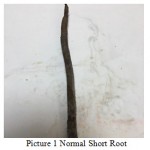 |
Figure 1
|
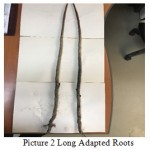 |
Figure 2
|
Gas exchange for living in anaerobic substrata the specialized roots of mangroves were important sites. There are numerous lenticels to the exposed surfaces [3]. In Avicennia there are pneumatophores possesses lenticel in upward direction of roots, through which passive diffusion of oxygen is carried out [5]. These lenticels may be opened or partially closed or fully closed depending on the environmental factors [6]. These pneumatophores are generally spongy and short (< 30 cm), instead they are much larger and become more numerous in Avicennia marina in anaerobic and oil affected conditions. These morphologic responses were increased in surface area for gas exchange [7].
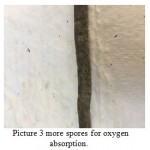 |
Figure 3
|
Wood Anatomy
Unique anatomical feature of mangrove wood is discussed and summarized by Tomilson (1986). On the basis of nodal number in leaf scar the easiest way to know or to estimate age of seedling belong to Rhizophora. The effect of temperature causes osmotic potential of sea water and the transpiration the mangrove wood have the best survival feature .There are several thin vascular bundles running through the stem which have density. The range of density is from 32 mm-2 in Excoecaria to 270 mm-2 in Aegiceras [8]. High tensions created by vessels in the xylem is due to a reduced diameter in the vessel to produce a disproportionally high increase in flow resistance [9-11]. The vascular bundles usually have basic small plates of perforation. Except the Kandelia candle from the family of mangroves Rhizophoraceae bearing scalar form perforation plates.
Seed coat and Seed anatomy
In the early embryonic histo differentiation in Avicennia marina forms an endosperm haustoria. In the initial growth phase, extra-ovular subsequent embryonic development takes place. Once mature, the seed, furthermore is enclosed by a pericarp, originates entirely from the wall of ovary. The mature seeds are abscised from the end of histo differentiation, the cotyledon cells contain large amounts of soluble sugars, they are highly vacuolated, and they act as the important food reserves of the mature seed [23].
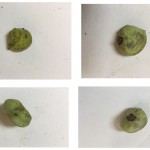 |
Scheme 2
|
Table 2: Leaf Characteristics of Avicenniaceae
| Avicenniaceae | Avicennia officinalis | Leaves are leathery, shiny, and medium size; Opposite and deccasate orientation; Ovate shape; Lamina elliptic and oblong; Rounded apex; Upper surface is glabrous; Midrib and viens are prominent; Small petiole with semi terrate and Exstipulate.
|
| Avicennia alba | Dark green leaves. Leaves are somewhat leathery. Oblong linear shape. Opposite leaves. Lamina linear. Acute apex, Mid rib somewhat swollen. Small petiole and exstipulate.
|
|
| Avicennia marina | Leaves are leathery, Medium size leaves. Opposite. Ovate shape, Lamina. Elliptic oblong. Somewhat rounded apex. Upper surface is glabrous. Midrib is prominent. Small petiole with exstipulate | |
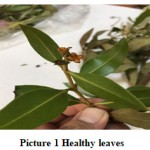 |
Figure a
|
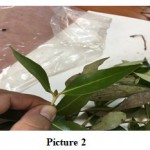 |
Figure b
|
Leaf (Table.2) thickness differs from species to species within the members of Avicenniaceae and the range is 327.83 μm to 666.60 μm. Mostly stomata are preset on lower surface, but in case of Sonneratiaceae, stomata were seen on both surfaces of the lamina. The average number of stomata per given area and the average leaf area was differs from species to species.
Conclusion
Mangrove ecosystems are receiving an increasing attention in the recent times but still we lack a much more amount of structural and functional information. There are still opening in different basic aspects in the study of reproductive biology among mangroves, there evolution and it is not properly understood. Still there is lack of knowledge and understanding in the level of energy involved among the food web in mangrove environment and their connection inside the ecosystem. There is a great need to understand the environmental changes and pollution on the ecosphere of mangrove. Still, studies are required to understand the organisms that are totally dependent on mangroves, especially with respect to their recruitment and larval supply.
References
- Araujo, R.J., Jaramillo, J.C., Snedaker, S.C., 1997. LAI and leaf size differences in two red mangrove forest types in south Florida. Bulletin of Marine Science 60(3), 643-647.
- Corredor, J.E., Morell, J.M., Klekowski, E.J., Lowenfeld, R., 1995. Mangrove genetics: III. Pigment fingerprints of chlorophyll-deficient mutants. International Journal of Plant Sciences 156(1), 55-60.
CrossRef - Das, P.K., Chakravarti, V., Dutta, A., Maity, S., 1995. Leaf anatomy and chlorophyll estimates in some mangroves. The Indian Forester 121(4), 289-294.
- Das, S., Ghose, M., 1996. Anatomy of leaves of some mangroves and their associates of Sunderbans, West Bengal. Phytomorphology 46(2), 139-150.
- Das, S., Ghose, M., 1998. Anatomy of the woods of some mangroves of Sunderbans, Wes
- Bengal (India). In: International Symposium on Mangrove Ecology and Biology, April 25-27, 1998, Kuwait, 10.
- Dodd, R.S., Fromard, F., Rafii, Z.A., Blasco, F., 1995. Biodiversity among West African, Rhizophora: Foliar wax chemistry. Biochemical Systematics and Ecology 23(7-8), 859-868.
CrossRef - Ellison, A.M., Farnsworth, E.J., 2001. Mangrove communities. In: Bertness, M.D., Gaines, S.D., Hay, M.E. (Eds.), Marine Community Ecology. Sinauer Associates, Sunderland, MA, USA, 423-442.
- Ish-Shalom-Gordon, N., Dubinsky, Z., 1992. Ultrastructure of the pneumatophores of the mangrove Avicennia marina. South African Journal of Botany 58(5), 358-362.
CrossRef - Li, M.S., Lee, S.Y., 1997. Mangroves of China: a brief review. Forest Ecology and Management 96, 241-259.
CrossRef - Li, Y., Li, Z., Lin, P., 2009. The Study on the Leaf Anatomy of Some Mangrove Species of China. In: International conference on Environmental Science and Information Application Technology, 2009. ESIAT 2009, Wuhan, China, 11-14.
- Nandy, P., Das, S., Ghose, M., Spooner-Hart, R., 2007. Effects of salinity on photosynthesis, leaf anatomy, ion accumulation and photosynthetic nitrogen use efficiency in five Indian mangroves. Wetlands Ecology and Management 15, 347-357.
CrossRef - Naskar, K., Guha Bakshi, D.N., 1995. Vegetation pattern of the Sundarbans. Mangrove Swamp of the Sundarbans- and Ecological perspective. Nayaprakash. Calcutta, India, 27-174.
- Parida, A.K., Das, A.B., Mittra, B., 2004. Effects of salt on growth, ion accumulation, photosynthesis and leaf anatomy of the mangrove, Bruguiera parviflora. Trees 18, 167-174.
CrossRef - Rafii, Z.A., Dodd, R.S., Fromard, F., 1996. Biogeographic variation in foliar waxes of mangrove species. Biochemical Systematics Ecology 24, 341-345.
CrossRef - Rico-Gray, V. and Palacios-Rios, M. 1996. Leaf area variation in Rhizophora mangle Rhizophoraceae) along a latitudinal gradient in Mexico. Global Ecology and Biogeography Letters 5(1), 30-35.
CrossRef - Saenger, P., Bellan, M.F., 1995. The mangrove vegetation of the Atlantic coast of Africa: A review. Universite de Toulouse Press, Toulouse, France, 96.
- Saifullah, S.M., Elahi, E., 1992. Pneumatophore density and size in mangroves of Karachi, Pakistan. Pakistan Journal of Botany 24(1), 5-10.
- Sobrado, M.A., 2007. Relationship of water transport to anatomical features in the mangrove Laguncularia racemosa grown under contrasting salinities. New Phytologist 173, 584-591.
CrossRef - The Botany of mangroves. Cambridge University Press, Cambridge, U.K., 413.
- Yoshihira, T., Shiroma, K., Ikehara, N., 1992. Profiles of polypeptides and protein phosphorylation in thylakoid membranes from mangroves, Bruguiera gymnorrhiza (L.) Lamk. and Kandelia candel Galaxea 11(1), 1-8.
- Yuanyue, L., Zhongbao, L., Peng, L., 2009. The study on the leaf anatomy of some mangrove species of China. In: International conference on Environmental Science and Information Application Technology 3, 47-51.

This work is licensed under a Creative Commons Attribution 4.0 International License.





